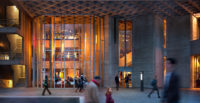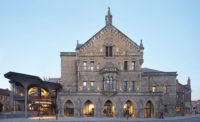Los Angeles, California
The Nokia Theatre is ready for its closeup. It’s well suited for panoramas, too. Many elements of this six-month-old Los Angeles venue were designed by ELS Architecture and Urban Design with Hollywood’s needs in mind.
Berkeley, California–based ELS was commissioned to take on this Nokia Theatre in 2002, just months after the client, AEG, had taken over a newly opened, ELS-designed theater in Grand Prairie, Texas. “The primary resemblance is in function,” ELS principal Kurt Schindler, AIA, says of similarities between the two buildings. Both seat approximately 7,000 people, and meld the intimacy of a performing arts center and the capacity of a headliner’s main stage. “A sports arena can turn into a concert venue holding anywhere up to 18,000 people,” Schindler notes, “but there are a lot of compromises in terms of acoustics, sight lines, and using special apparatuses.”
For the Los Angeles project, the designers adapted the expertise honed in Grand Prairie to local culture—and specifically to the entertainment industry. For example, the Nokia Theatre auditorium’s orchestra level seats 4,000 guests. It has one of the largest indoor stages in the nation, so “an award nominee can sit in the audience with his whole entourage,” Schindler explains. “They call his name and the television camera can get the shot of him running up to the stage and hugging people in the aisle. That drives a lot of the basic concept of the auditorium.”
Jeff Zieba, AIA, associate principal of ELS, thinks of Nokia Theatre as designed from the inside out, particularly concerning the massing of the 250,000-square-foot building, which squeezes into a 2.5-acre trapezoidal site next to Staples Center, a major sports arena. Even so, a variety of exterior features also carefully consider the Hollywood awards show. To emphasize the auditorium, Alucobond composite panels stop short of the soffit, Zieba says. “There is a series of bays where the structure of the columns and trusses is expressed.” These coves include 1,000-watt metal halides that uplight the roof in blue, “filling the space with light and alluding to something happening inside.” That brightness also attracts camera crews filming from the sky. (The adjacent plaza, designed by Los Angeles–based Rios Clementi Hale Studio, grabs the attention of blimp-borne cameras thanks to a boldly striped paving pattern.) And on the theater’s roof, a grid of metal halides with blue glass lenses and an LED-illuminated Nokia sign align almost perfectly with those of Staples Center, making for a more harmonious image for the television audience as that birds-eye view flashes across the screen.
Appropriately, the Nokia Theatre already has bagged the events for which it was designed, including the American Music Awards, Latin Grammys, ESPY Awards, and the finals of American Idol. Equally important, the building and plaza kick off further development of L.A. Live, a $2.5 billion AEG project that includes construction of other performance venues, movie theaters, restaurants, a Grammy museum, and office and hotel facilities. “AEG is striving for this to be the entertainment capital of Los Angeles and the West Coast, rivaling Times Square,” Schindler explains.
In that vein, the Nokia Theatre design attempts to balance the building’s status as an awards-night destination and as a component of a soon-to-be neighborhood. The exterior takes its cues from Staples Center, with corresponding rooftop lighting schemes and Nokia’s Alucobond skin directly referencing its predecessor. But moreover, slight modulation of the panels’ colors and banding nearing the sidewalks provides the structure with a more human scale. And the Nokia Theatre’s east elevation is a 50-foot-tall curtain wall that reveals to passersby three lobby levels and a color-changing, LED-illuminated atrium, a feature that Schindler says “adds life to the street.”




Post a comment to this article
Report Abusive Comment